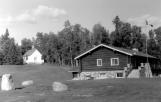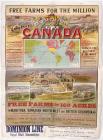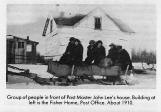2
The Land Act of 1873 set a large scale survey project in motion. Range and township lines were to subdivide the entire country into sections, administered through land title offices and, in the west, available for homesteading at certain conditions.On the Aboriginal reserves food remained scarce. Producing farms took time to establish and in 1896 extra land was set aside for the four bands who resided near Hobbema: the Samson, Louis Bull, Ermineskin and Montana bands. This gave additional access to fishing and trapping. Most of the people who were still living along the north shore now migrated to the reserve on other side of the lake.
4
The first person to secure a title to the former mission grounds was John Lee. John Lee grew up in the Pigeon Lake area, was born at "Fisher Home" and was married to Louise.The couple ran the Fisher Home post office and stopping house plus store, well situated above the artesian spring, near the trails from Edmonton to Rocky Mountain House and from Hobbema to Lac Ste. Anne.
Later the post masters moved the operation to the current Gilwood Beach, the former site of the trade post.
5
Hauling logs at the north end of Pigeon Lake.1913
Pigeon Lake, Alberta
 Credits:
Credits:Glenbow Archives na-2636-4
6
Logging was the obvious industry: settlers came and houses were needed. Edmonton was growing and needed huge quantities of lumber. Logging camps offered employment and the lake provided transportation from the clearings to the mill. Logs were boomed across the water or loaded on wagons.Rowley's Mill on the northeast shore, at today's summer village of Mulhurst Bay, was one of the largest mills in the area; but far from the only one.
7
Fishing through ice at a clearing on a lake.February, 1934
?
 Credits:
Credits:National Library and Archives of Canada a034851
8
Fishing remained an important industry, primarily in winter. In the hamlet of Mulhurst a group of business minded fishermen formed the Pigeon Lake Fish Co-op, and auctioneer Steinke did the selling for them. But the Mission Beach men, like Quick, Renus, Christofferson and Dahl did their own brokering. Willie Remus and Sweet Christofferson had their own fish packing houses. They sold their fish directly to owners of Chinese restaurants in Edmonton.10
Not all logs were milled into lumber. Many were directly incorporated into new houses. Hobart Dowler became a log builder of renown. Not only around Pigeon Lake, but all through the province can one find his buildings with their characteristic stone foundation and fire places.Hobart Dowler had come to Alberta as a young farmer around 1900. He developed a friendship with the Rev. John McDougall, who fired his interest in the land on the north shore of Pigeon Lake. After he had established his building business while mostly living in the houses under construction, he finally purchased the former mission lands. His houses could now be built in his log yard, where each piece was numbered. The house was then disassembled and re-constructed on its final location.
12
In 1949 local United Church clergyman named Gerald Hutchinson asked, "Why is this place called Mission Beach?" He started to knock on the doors of long-time residents. This is how Gerald Hutchinson came to meet Hobart Dowler. Their common interest in the mission's history resulted in their plan to ensure the story would not be forgotten. On October 7, 1956 the first meeting of the Rundle's Mission Society was held.In 1958 Hobart Dowler built the Rundle Memorial Lodge.
13
The Rundle Memorial Lodge, built by Hobart Dowler in 1958, is a meeting place in the community.5 May 2006
Pigeon Lake, Alberta

14
Today, in 2006, the former mission grounds have become a Provincial Historic site and the Rundle's Mission Society provides interpretive programs as well as a meeting place for the community. Its facilities offer accommodation for groups both in summer and winter.The artesian spring, which has quenched the thirst of many generations of visitors, still never freezes.



